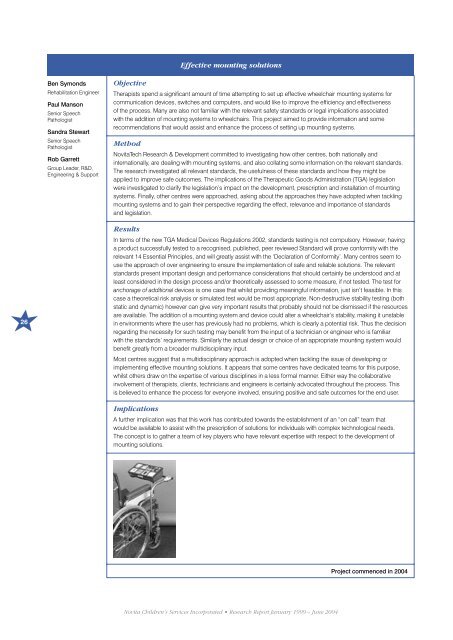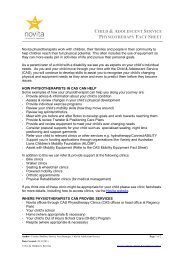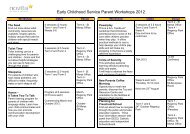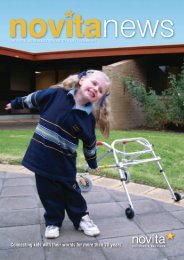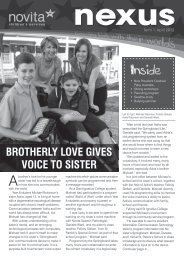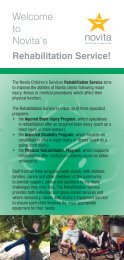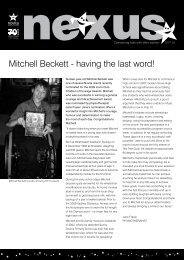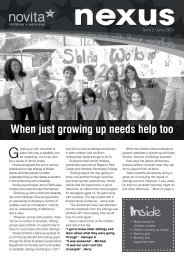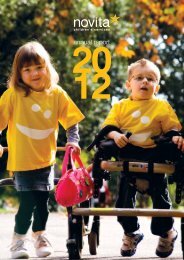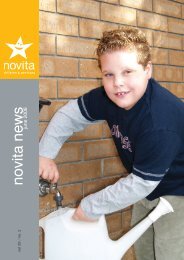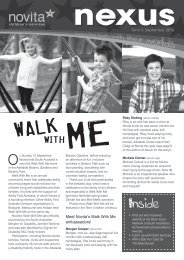Novita Research Report January 1999 - Novita Children's Services
Novita Research Report January 1999 - Novita Children's Services
Novita Research Report January 1999 - Novita Children's Services
You also want an ePaper? Increase the reach of your titles
YUMPU automatically turns print PDFs into web optimized ePapers that Google loves.
Effective mounting solutions<br />
Ben Symonds<br />
Rehabilitation Engineer<br />
Paul Manson<br />
Senior Speech<br />
Pathologist<br />
Sandra Stewart<br />
Senior Speech<br />
Pathologist<br />
Rob Garrett<br />
Group Leader, R&D,<br />
Engineering & Support<br />
Objective<br />
Therapists spend a significant amount of time attempting to set up effective wheelchair mounting systems for<br />
communication devices, switches and computers, and would like to improve the efficiency and effectiveness<br />
of the process. Many are also not familiar with the relevant safety standards or legal implications associated<br />
with the addition of mounting systems to wheelchairs. This project aimed to provide information and some<br />
recommendations that would assist and enhance the process of setting up mounting systems.<br />
Method<br />
<strong>Novita</strong>Tech <strong>Research</strong> & Development committed to investigating how other centres, both nationally and<br />
internationally, are dealing with mounting systems, and also collating some information on the relevant standards.<br />
The research investigated all relevant standards, the usefulness of these standards and how they might be<br />
applied to improve safe outcomes. The implications of the Therapeutic Goods Administration (TGA) legislation<br />
were investigated to clarify the legislation’s impact on the development, prescription and installation of mounting<br />
systems. Finally, other centres were approached, asking about the approaches they have adopted when tackling<br />
mounting systems and to gain their perspective regarding the effect, relevance and importance of standards<br />
and legislation.<br />
26<br />
Results<br />
In terms of the new TGA Medical Devices Regulations 2002, standards testing is not compulsory. However, having<br />
a product successfully tested to a recognised, published, peer reviewed Standard will prove conformity with the<br />
relevant 14 Essential Principles, and will greatly assist with the ‘Declaration of Conformity’. Many centres seem to<br />
use the approach of over engineering to ensure the implementation of safe and reliable solutions. The relevant<br />
standards present important design and performance considerations that should certainly be understood and at<br />
least considered in the design process and/or theoretically assessed to some measure, if not tested. The test for<br />
anchorage of additional devices is one case that whilst providing meaningful information, just isn’t feasible. In this<br />
case a theoretical risk analysis or simulated test would be most appropriate. Non-destructive stability testing (both<br />
static and dynamic) however can give very important results that probably should not be dismissed if the resources<br />
are available. The addition of a mounting system and device could alter a wheelchair’s stability, making it unstable<br />
in environments where the user has previously had no problems, which is clearly a potential risk. Thus the decision<br />
regarding the necessity for such testing may benefit from the input of a technician or engineer who is familiar<br />
with the standards’ requirements. Similarly the actual design or choice of an appropriate mounting system would<br />
benefit greatly from a broader multidisciplinary input.<br />
Most centres suggest that a multidisciplinary approach is adopted when tackling the issue of developing or<br />
implementing effective mounting solutions. It appears that some centres have dedicated teams for this purpose,<br />
whilst others draw on the expertise of various disciplines in a less formal manner. Either way the collaborative<br />
involvement of therapists, clients, technicians and engineers is certainly advocated throughout the process. This<br />
is believed to enhance the process for everyone involved, ensuring positive and safe outcomes for the end user.<br />
Implications<br />
A further implication was that this work has contributed towards the establishment of an “on call” team that<br />
would be available to assist with the prescription of solutions for individuals with complex technological needs.<br />
The concept is to gather a team of key players who have relevant expertise with respect to the development of<br />
mounting solutions.<br />
Project commenced in 2004<br />
<strong>Novita</strong> Children’s <strong>Services</strong> Incorporated • <strong>Research</strong> <strong>Report</strong> <strong>January</strong> <strong>1999</strong> – June 2004


